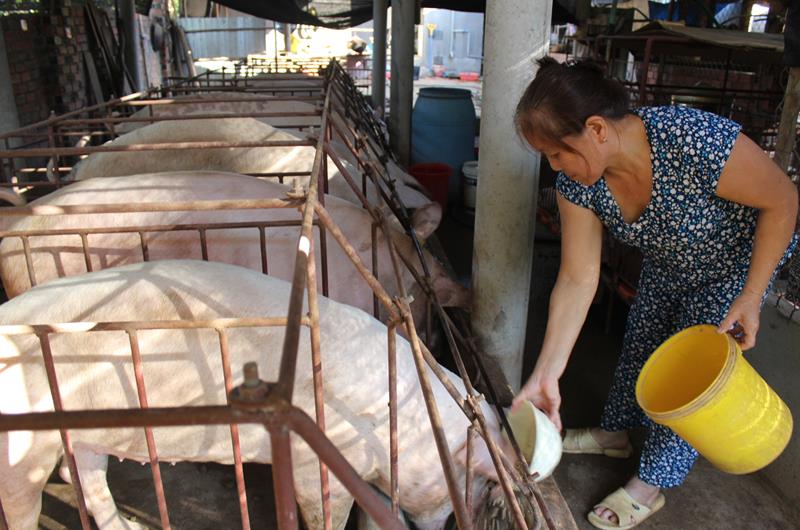In the past few months, the price of live hog has been stable at the level of low-profit or even non-profitable farmers due to abundant supply and difficult consumption market.

Pig farm in Thong Nhat district. Photo: B.Nguyen
Accordingly, the Government Office has just issued Official Letter No. 7785/VPCP-NN sent to the Ministry of Agriculture and Rural Development and related ministries, conveying the direction of Deputy Prime Minister Le Van Thanh on coordination on joint research on pork export issues. The reason is that the domestic pork supply is in excess and there are many suggestions that the Government should loosen the barriers to sell pigs across the border.
Facilitating pork exports
Over the past several months, the supply of pork products has increased while domestic demand has decreased, causing an imbalance between supply and demand, leading to a decrease in prices. There are many times, the price of live pigs fluctuates around 50,000 VND/kg. This price is from several thousand to tens of thousands of dong/kg lower than the production cost. Meanwhile, input costs increased but the selling price of output products dropped sharply, causing many difficulties and great pressure for farmers. The reason is that the domestic economic situation is difficult, the income of workers is reduced, most consumers have to tighten their belts, so the purchasing power of pork in the market is getting weaker and weaker, lead to a sharp drop in the price of live pigs.
According to the official letter of the Government Office, Deputy Prime Minister Le Van Thanh assigned the Ministry of Agriculture and Rural Development to assume the prime responsibility for, and coordinate with the Ministry of Industry and Trade and relevant agencies in, studying contents related to removing barriers to pork export. The Deputy Prime Minister also requested the Ministry of Agriculture and Rural Development to proactively implement appropriate solutions to develop the livestock industry sustainably, meeting food demand, especially during the New Year and Lunar New Year 2023, ensure the interests of farmers
According to the Ministry of Agriculture and Rural Development, currently, Vietnam does not limit the quota of exporting pigs and pork products. However, in order to export pigs and pork products, individuals and businesses must meet the requirements of the import markets. This is also something that many businesses that want to export have not been able to do.
Pork exports are currently facing difficulties with trade barriers from other countries. Specifically, in addition to the important criterion of proving meat quality, ensuring traceability and doing well at all stages related to disease prevention and treatment, compliance with trade protection regulations of the importing country is a major barrier. In particular, each country that imports pork from Vietnam such as Myanmar, Indonesia, Africa... has its own regulations.
Small slaughterhouses are also barriers
According to the Association of Livestock and Enterprises, the limitation in slaughtering in the province is still fragmented and small, which is also a barrier in promoting pork consumption to domestic and export markets.
Mr. Nguyen Tri Cong, Chairman of Dong Nai Breeding Association, said that it is unreasonable that traders have to bring live pigs from Dong Nai to Long An for slaughter and then return them to Ho Chi Minh City for consumption. Meanwhile, in Dong Nai province, there is no shortage of businesses interested and looking forward to creating favorable conditions for policies and environment to invest in a modern slaughter system to meet the demand for large-capacity pig slaughter. After the Covid-19 epidemic, many slaughterhouses and private enterprises in the livestock industry that used to operate very well are now facing difficulties, hoping to create conditions to access capital to maintain their operations.
Sharing the same view, Mr. Nguyen Van Ngoc, Vice Chairman of the Southeast Poultry Association shared, in other countries, livestock production is associated with chain slaughter, so that product quality can be controlled from production, slaughter to distribution. Meanwhile, in Vietnam, this process is divided into many service segments, pushing up product prices, contributing to affecting product output. Areas with land planning for livestock and slaughter are currently facing the situation that the land fund is mainly in the hands of speculators, causing land prices to be pushed up; Livestock investors are really difficult or inaccessible. I hope that localities planning investment areas for slaughter and livestock should organize auctions for land prices for investors in need.
According to a report by the provincial Department of Agriculture and Rural Development, the province currently has 72 cattle and poultry slaughtering establishments licensed to operate and do business. For chicken slaughterhouses, the facility with the highest capacity is about 30,000 heads/day; the remaining average is about 3,000 animals/day. For pig slaughter, the facility has a large capacity of about 400 heads/day, the rest mainly reaches an average of 50-100 heads/day.